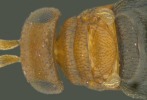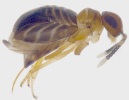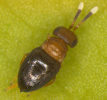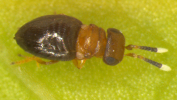Scientific name
Neodusmetia sangwani (Subba Rao) (=Dusmetia indica Burks, Dusmetia sangwani Subba Rao)
Taxonomic position
Hymenoptera: Encyrtidae: Tetracneminae: Neodusmetiini
Diagnosis
Female: Head and mesosoma (thorax) yellowish brown, antenna with scape and pedicel yellowish brown, funicular segments more or less brown, club white; metasoma (abdomen / gaster) dark brown; legs yellowish brown. Antenna inserted almost on mouth margin, with six-segmented funicle and three-segmented club. Frontovertex twice as broad as length of scape. Visible part of mesoscutum at least three times as broad as long, subequal to pronotum. Wings brachypterous, greatly reduced, fore wing reaching just anterior margin of first visible abdominal tergite.
Male: Dorsal side more or less uniform dark brownish black, with normal wings.
Readily identified by the brachypterous nature of the adult female and the host ( Antonina spp. on grasses).  Adult female - head & thorax Adult female - head & thorax
Images


 Adult female in dorsal view Adult female in dorsal view





 Adult
Adult
Distribution
Distributed probably throughout India. Bangladesh; Pakistan; Philippines; Australia; Hawaii; Introduced and established in many countries such as USA, Israel, Brazil and Bermuda (Hayat, 2007).
Hosts / Biology
Parasitoid of Antonina graminis (Green) (=A. indica), Antonina sp. on grasses like Cynodon dactylon, Rhodes grass, Eragrastes ciliaris, etc. It was introduced in the USA in 1959 and released in southern Texas during 1959-60. It became well established and reduced the pest population significantly. This example of complete biological suppression is regarded as a classic for Texas. The Texas economy benefitted by $177 million annually as a result of increased number of calves produced and the maintenance cost of turf grasses was reduced by $17 million a year.
Total funding of this project at Weslaco did not exceed $ 200,000. This parasitoid was later introduced into Bermuda and northern Brazil, where it proved to be a success (Simmonds, 1972; Dean et al., 1979). It is one of the most successful bioagents exported from India to different parts of the world.
References
- Dean, H.A., Schuster, M.F., Boling, J.C. and Riherd, P.T. 1979. Complete biological control of Antonina graminis in Texas with Neodusmetia sangwani (A classic example). ESA Bulletin 25(4): 262-267.
- Kerrich, G.J. 1964. On the European species of Dusmetia Mercet and a new Oriental genus (Hym.; Chalcidoidea, Encyrtidae). Entomophaga 9(1): 75-79.
- Simmonds, F.J. 1972. Approaches to biological control problems. Entomophaga 17: 251-264.
- Subba Rao, B.R. 1957. Some new species of Indian Hymenoptera. Proceedings of the Indian Academy of Sciences (B) 46: 385.
|